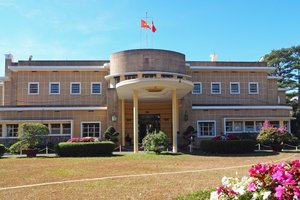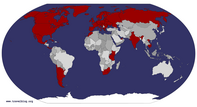Advertisement
Published: March 5th 2017

 Emperor's Summer Palace
Emperor's Summer Palace
Faded glory of a different ageA “late” morning – we didn’t leave until 8:30 for our tour of city sights.
The
Summer Palace of
King Boa Dai, the last King of Vietnam, was initially somewhat disparaged by Thuy, but she had to admit that it had improved, possibly because of the recent New Year celebrations. The building was of gracious art deco design, and the rooms were furnished relatively simply with large soft chairs and dark polished wood. Photographs showed mainly the political life of the royal family. Most inviting was the room of
Queen Nam Phuong because of its rich, soft, crème-caramel decor. From a balcony the contemplation garden looked splendid – a French formal garden with gorgeous flowers and an oriental fountain.
Our next destination was the “
Crazy House”, unknown to me but not to others in our group. The owner and architect worked on the bizarre construction for years. The overall effect reminded me of the naturally occurring overgrowth at
Ta Prohm in Cambodia and also the
Sagrada Basilica, the
Gaudi basilica in Barcelona. Now a hotel, the rooms were tucked into caverns formed by artificial tree roots; stairs twisted up as if one were climbing a vine. The original imagination boggles the mind. (I later learned that the

 The Crazy House
The Crazy House
Your eyes say gravity doesn't work!owner and designer,
Hang Nga, was inspired by Gaudi, also Disney and Dali. She persisted through years of official disapproval to create a personal home and guesthouse.)
Then we changed transportation, taking a train now used for tourism about twelve kilometres up above Da Lat. At first it didn’t seem like much more than a rackety ride on an old train; however, once we passed the trees and bushes along the tracks, we found ourselves over-looking the thousands of greenhouses for vegetables and cut flowers that create the fame of Da Lat. Sometimes we could see right into greenhouses with seedlings and others with crops being harvested. Very few workers could be seen, although the industry must be a major employer. These views confirmed that this is a prosperous city with many attractive, well-proportioned houses set in lovely gardens. Of course, there is also a fair share of less substantial houses. Da Lat is a more orderly city than Ho Chi Minh - streets laid out more carefully and far fewer people doing business on the sidewalks. Partly this is due to the French having designed the original town for their pleasure, and partly the much cooler weather requires people

 Growing flowers
Growing flowers
... and the Vietnamese love cut flowers!to have reasonable homes that can be heated.
From the train stop, we walked a few blocks to the
Linh Phuoc Pagoda. This complex of about five buildings was mind-boggling: the tall structures were completely covered in huge ceramics of dragons and mythical people. At first we visited the main temple’s towering gold (painted) Buddha where people were doing their individual worship, including Thuy. Stepping outside, I encountered a shop doing a bustling trade in all kinds of food stuffs, from innumerable varieties of tea to candied ginger and plums to three varieties of dried beans to jars of preserved fruits and vegetables. To one side, meals were being eaten picnic style by circles of people, perhaps families or friends travelling together. Stepping outside again, I crossed through the usual conglomeration of slowly moving honking taxis, vans and motorbikes, to another huge temple. Inside was a multi-storey representation of either Buddha or a saint. On both sides were lines of (gold painted) statues, of holy people presumably. This temple lacked the ornate design of the others, but immediately next to it was the most ornate of all – a large four-storey building entirely covered with ceramics, including the staircases (the actual

 Linh Phuoc Pagoda
Linh Phuoc Pagoda
A passion for decorative tributes!steps were tile). Inside was a Buddha the full height of the building flanked by ranks of golden statues on all of the arcaded balconies. From here I noticed another building where on the second floor people were pasting prayers on a large brass bell, which they then tapped with a large horizontal log. I went over to watch but couldn’t see where they were getting the papers. Suddenly I became conscious of the time and realized I was late for the bus!
Just before lunch, Thuy brought us to the
University of Da Lat, where she studied for four years in the early eighties. The University still functions as a teacher training college, and her friend who still teaches there came to greet us. The story is quite sad because after winning the war in 1975, the administration of the country and its economy collapsed. Teachers were respected but paid very poor salaries. As a student Thuy and her husband literally starved, to the degree that it weakened her son born during that time. That is why she left teaching and eventually became a tour guide. The University is small and looks quite nice with a lovely curved building around a

 Da Lat University
Da Lat University
Privileged to see Thuy's alma materlarge open courtyard, but Thuy said that at the time she was studying it was a dump. Vietnam has come a long way in its reconstruction and rehabilitation.
After lunch we went to the newly refurbished and reopened
King’s Palace, the same King Boa Dai whose Summer Palace we visited this morning. A graceful building of French Colonial design (yellow and white as is common here), its arrangement of rooms was much the same as the Summer Palace. According to a sign, many of the major decisions and agreements for reunification were negotiated in the conference room. The gardens were extensive, with many tall trees and colourful flowerbeds. We goofed around taking pictures with some cartoon-like characters in the forecourt that were left from the New Year celebrations.
For the big event of the afternoon we drove a short way out of town; houses and shops continued the whole way.
Lang Biang is the highest mountain in the area; Da Lat is 1500m and Lang Biang is 2100m. Although walking was an option, we preferred taking Russian jeeps on a bumpy ride along a curvy road over a considerable distance. The mountain was forested, although not thickly. At the top

 Emperor's Summer Palace
Emperor's Summer Palace
Harmony and colour now for allthe distant hills and dark clouds framed the magnificent view of the Da Lat valley and lake. The developed park was not too interesting until we came to the local vendors and attractions. Today the weather has been slightly drizzly. Either because of the season or the weather, there were few stalls were open. However, one woman of the Lat minority group, whose traditional lands are here, was selling colourful bags and scarves. I first I dismissed these from afar, but on closer scrutiny I thought the scarves were unusual. With Thuy’s help I discovered that they were wool woven by the vendor herself; she showed us her yarn but kept it covered because of the rain. The scarves were soft, long and brilliantly coloured. I chose a red one with several accent colours; the price was 150,000 dong, or about $US7.50. That’s a bit expensive as things go in Vietnam, but I was charmed to meet the artist, and through Thuy she agreed to a photo with her holding my scarf. A short distance away, Elizabeth paid the same price to hold a Mountain Eagle, trained by a local handler. He set her up with his romantic hat (black

 Scarf vendor
Scarf vendor
Proud of her work, deservedly so!leather cowboy style with tall eagle feather) and took photos. Then he let her pet the bird, which wasn’t the least disturbed by the attention. It stood tall and proud - mostly white with some brown and grey feathers, and two feathers formed a tall topknot on its head.
At the bottom of the hill again, we drove to a nearby Lat village. Thuy took us into the Catholic church, where the Christ carved in highly polished wood was sensuous in its muscularity. Nearby was a staff with simple ornaments dangling from cross pieces. Apparently it is usually displayed outside in the front, but it was brought inside for the New Year celebration. Across the street, Thuy knocked on the door of a plain, dark brown wooden house, and after a tense few moments, out came a lively man (born 1944 he later said) who was the village leader. He took us into what might have been a barn once or was a party hall for drinking, about 15’x20’. Benches ranged on both long sides, and a fairly large fire pit was in the middle.
He invited us to sit on the benches and sat himself on a

 Lat village church
Lat village church
Imaginative approach to worshipstool in front of us. A passionate speaker, he told us a bit about his life, in heavily accented English. As a Lat, he was a supporter of the US in the war and worked for the Army as a nurse (not quite sure if it was the American army or the South Vietnamese army). Thuy commented later that the people here were American supporters in the daytime and Viet Cong supporters during the night; at the least, he would have treated any wounded Vietnamese needed help. He worked in the hospital in Saigon and Da Lat, but after the war he quit. He said that the drugs used during the war were American and Vietnamese, and after the war they were Chinese and Russian; he didn’t want to do the studying that the change required. He also told us that as an ordinary nurse, he didn’t have to attend re-education camp, unlike the doctors. Thuy told us later that only the senior doctors who were also managers had to attend the camp, because the country was too short of medical staff to let all of them go. One of our group was a US Vet, so he and the

 Lat village head
Lat village head
A true story-teller!village leader shook hands and clapped each other on the back in nostalgic solidarity. The village leader spoke better French than English, and when he discovered that three of us understood French, he told much the same stories again in French.
He sang a Quebecois folksong in honour of Elizabeth and me, the only Canadians on this tour, which was charming. At Thuy’s instigation, he also sang some local folksongs, accompanying himself on local instruments, a gong/drum and a wind/reed gourd. His final bit of hospitality was the invitation to taste the local sticky-rice “wine” (homebrew), for which he produced a number of “straws” ingeniously made of bamboo and plastic tubing. This was one thing I didn’t try – it was so strong we could smell it.
Dinner: Artichokes, DIY spring rolls, rice, delightfully gingery catfish hotpot, grilled beef, snow peas and straw mushrooms, Tiger beer
">View the video of Linh Phuoc Temple.

























Isabel Gibson
non-member comment
Another amazing day
A Quebecois folk song in Vietnam - who would have guessed? The indigenous architecture and decoration reminds me a bit of Thailand - detailed to the point of ornate. But then there's the preservation of the art deco style - even though it was introduced, I presume, by colonial "masters." Was there any discussion of cultural aspects of ornamentation?